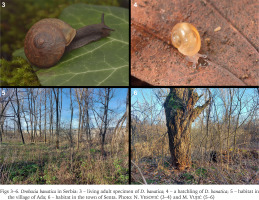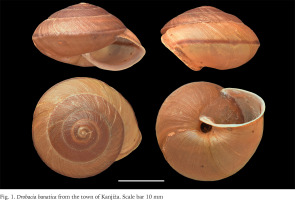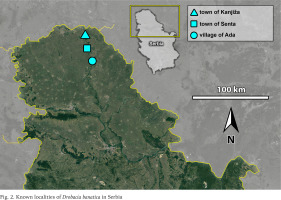Drobacia banatica (Rossmässler, 1838) (Fig. 1) is a relatively large pulmonate, helicid gastropod belonging to the subfamily Ariantinae (Schileyko 2013). It is characterised by a globular shell with a shallow suture and a sharp keel located at the centre of the periphery of the last whorl. A relatively narrow brownish band runs right above the keel. The umbilicus is open and deep. The shell surface is sculptured with rough radial growth lines, which are crossed by much finer spiral striae (Welter-Schultes 2012). The recent distribution of the species is primarily in Romania (where most sampling sites are located), but several localities are known in Ukraine and Hungary, mainly along the Romanian border (see: Domokos et al. 2018 for a comprehensive distribution summary). The fossil distribution of the species, in addition to the countries mentioned above, includes Germany, Poland, Czechia, Slovakia, and Austria (Domokos et al. 2018). Drobacia banatica is a relict, Natura 2000 indicator species protected in Hungary, Ukraine, and Romania. It is also considered threatened in the Carpathians (Shcherbak 1994, Witkowski et al. 2003, Akimov 2009, Balashov 2016). In Europe, it is classified as least concern (LC) due to its wide native range (Páll-Gergely & Seddon 2022). This species has not previously been recorded in Serbia. According to the distribution map by Domokos et al. (2018), Serbia is on the edge of the species distribution, making new findings in the country especially significant. Discovering this species in Serbia is not surprising since many localities in Romania and Hungary are close to the Serbian border. The absence of previous records could be explained by its limited distribution in Serbia and insufficient research (the latter is especially likely since the specimens of this species can be considered large and easy to spot in the field). We have found D. banatica in Serbia at three sampling sites, all in the northern lowland part of the country (Fig. 2). The snails were found in Vojvodina province, in riparian forests along the Tisza River (Figs 3–6), one of the suitable habitats for the species (Domokos et al. 2018). The first two empty shells were found near the village of Ada (45°47′04″N, 20°09′01″E) (Figs 2, 5), close to the river. The habitat in Ada is a natural riparian forest, with dominance of white poplars and willows. A plantation of clonal poplar is already present 100 meters upstream and downstream from the locality where the species was collected. Accompanying gastropod species at this habitat were Vallonia pulchella (O. F. Müller, 1774), Cochlicopa lubrica (O. F. Müller, 1774), Succinea putris (Linnaeus, 1758), Succinella oblonga (Draparnaud, 1801), Zonitoides nitidus (O. F. Müller, 1774), Fruticicola fruticum (O. F. Müller, 1774), Euomphalia strigella (Draparnaud, 1801), Cernuella virgata (Da Costa, 1778), Xerolenta obvia (Menke, 1828), Caucasotachea vindobonensis (C. Pfeiffer, 1828) and Helix pomatia Linnaeus, 1758. The second location was further north in the town of Senta (45°56′11.50"N, 20°05′26.38″E) (Figs 2, 6). At this site, we were able to collect two living subadult individuals. The habitat in Senta is a narrow, riparian, forested zone along Tisza’s course (a frequently visited beach in Senta is located close to the sampling site of this species). The dominant trees at the locality are white poplars, willows and pedunculate oaks. Accompanying gastropod species at this habitat were V. pulchella, C. lubrica, Z. nitidus, S. putris, Deroceras sturanyi (Simroth, 1894), Limax maximus Linnaeus, 1758, Arianta arbustorum (Linnaeus, 1758), X. obvia, C. vindobonensis and H. pomatia. A large population was found at the third site, near the town of Kanjiža (46°04′02.62″N, 20°04′10.10″E) (Fig. 2), with all specimens (ca. 20) found living in the leaf litter near the riverbank. The habitat in Kanjiža is the highly fragmented plantation of clonal poplar, Populus × euramericana, heavily overgrown by invasive plant, false indigo-bush Amorpha fruticosa.
Figs 3–6
Drobacia banatica in Serbia: 3 – living adult specimen of D. banatica; 4 – a hatchling of D. banatica; 5 – habitat in the village of Ada; 6 – habitat in the town of Senta. Photo: N. Vesović (3–4) and M. Vujić (5–6)

Shells were collected manually and photographed using a Nikon D5300 camera mounted on a tripod. They were measured using a digital hand caliper. Shell width and height of the largest specimen measured was 26.92 mm and 16.72 mm respectively while the smallest was 23.50 mm and 13.56 mm respectively. The mean shell width was 25.31 mm and the mean shell height was 15.77 mm.
We still need to learn more about this species’ distribution in Serbia and its population status. New sampling sites will likely be discovered since some suitable habitats exist for this species in Vojvodina, primarily along river courses. The sampling sites of this species in Serbia are among the westernmost for the species within its native range. Given the protection status of this species in other countries within its native range, it is highly recommended that D. banatica would become protected at the national level in Serbia, and efforts towards this have already begun. Given the protection status of D. banatica in the region, further investigations are necessary to assess the main threatening factors, and implement appropriate conservation measures.



